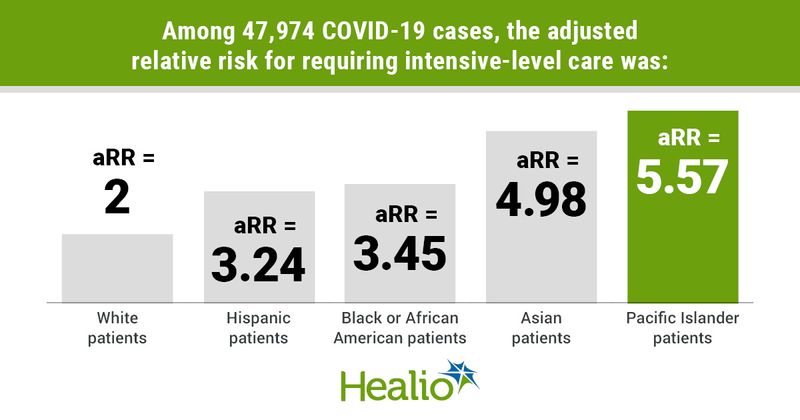Large cohort study shows racial disparities in COVID-19 rates, hospitalizations
Data from a cohort of nearly 48,000 individuals showed that Hispanic, Black or African American, Asian and Pacific Islander patients were more likely than white patients to be diagnosed with COVID-19 and require hospitalization or intensive care.
“Prior research has often been limited by small, nondiverse samples or lack of reliable clinical data to provide a detailed picture of COVID-19-related inequities across multiple racial/ethnic groups in the same population,” Claudia Nau, PhD, a research scientist in the division of behavioral research at Kaiser Permanente Southern California health system in Pasadena, and colleagues wrote. “Some studies suggest that racial/ethnic disparities in comorbidities and obesity may be major drivers of racial inequities in COVID-19 outcomes.”

Nau and colleagues conducted a retrospective cohort study of electronic health record data from Kaiser Permanente Southern California. The analysis included 47,974 adults (mean age, 44.1 years; women, 54.7%) with COVID-19. Among them, 69% were Hispanic, 17% were white, 6.7% were Asian, 6.5% were Black or African American and 0.8% were Pacific Islander. The study’s outcomes of interest included testing positive for COVID-19, requiring hospitalization and requiring intensive-level care. The researchers wrote that death was not included as an outcome of interest “because some racial/ethnic groups had fewer than 10 cases.”
Among the 47,974 COVID-19 cases, 9.42% required hospitalization and 3.12% required intensive-level care. Racial disparities in outcomes persisted after the researchers adjusted the analysis for age, sex, comorbidities and BMI.
The adjusted relative risk (RR) for testing positive or being diagnosed with COVID-19 was highest for Hispanic patients at 2.48 (95% CI, 2.45-2.51) and lowest for white patients at 0.83 (95% CI, .81-.85). It was 1.07 (95% CI, 1.04-1.11) for Asian patients, 1.16 (95% CI, 1.12-1.2) for Black or African American patients and 1.48 (95% CI, 1.33-1.63) for Pacific Islander patients.
The adjusted RR for hospitalization was lowest for white patients at 7.01 (95% CI, 6.51-7.51); it was 9.52 (95% CI, 9.17-9.87) for Hispanic patients, 13.72 (95% CI, 12.39-15.05) for Asian patients, 10.78 (95% CI, 9.75-11.81) for Black or African American patients and 13.22 (95% CI, 9.48-16.96) for Pacific Islander patients.
The adjusted RR for requiring intensive-level care was also lowest for white patients at 2 (95% CI, 1.73-2.27); it was 3.24 (95% CI, 3.03-3.45) for Hispanic patients, 4.98 (95% CI, 4.18-5.78) for Asian patients, 3.45 (95% CI, 2.86-4.03) for Black or African American patients and 5.57 (95% CI, 3.2-7.93) for Pacific Islander patients.
“Inequities in COVID-19 outcomes are a call to action for a culturally appropriate pandemic response and vaccination strategies that go beyond addressing comorbidities and account for factors like distrust in the medical system, resource constraints, language proficiency, and health literacy,” the authors wrote.


